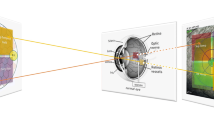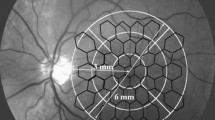Abstract
Summary
To evaluate the influence of hard exudates on macular function in patients with diabetic retinopathy.
Methods
Thirty seven eyes from 27 diabetic patients, aged 57 ± 14 years, diabetes duration 12.5 ± 9 years, not previously treated with photocoagulation, underwent fundus photography, multifocal electroretinography (mfERG) and optical coherence tomography (OCT). Hard exudates were graded from fundus photography with superimposed OCT and a superimposed hexagonal pattern (mfERG) by one retinal specialist, unaware of mfERG and OCT results. We defined three groups; A = eyes with exudates in the analyzed zone, B = eyes with no exudates in the analyzed zone but elsewhere, and C = eyes with no exudates. The mfERG responses and OCT values from five defined areas in the macula were compared.
Results
MfERG showed that the implicit time was significantly prolonged in group A compared to group C in the central, middle and outer areas and in the nasal and temporal area (p = 0.045, 0.019, 0.017 and 0.035 and 0.016 respectively), in group B compared to group C in the central area (p = 0.016), and in group A compared to group B in the outer area (p = 0.035). Amplitude differed between group A and C in the middle area and outer area (14.2 ± 5.2 nV/deg2 vs 21.1 ± 8.7 nV/deg2, p = 0.037 and 14.1 ± 3.9 nV/deg2 vs 17.7 ± 7.1 nV/deg2 , p = 0.02 respectively), and between group B and C in the temporal area 14.5 ± 2.2 nV/deg2 vs 20.0 ± 8.7 nV/deg2, p = 0.017). Macular thickness assessed with OCT was similar between the groups.
Conclusions
In eyes with diabetic retinopathy, hard exudates prolong the implicit time assessed with mfERG, compared to eyes without hard exudates, and independently of macular thickness. These results indicate that the hard exudates in the macular region, even at a distance from the fovea centre, have a deleterious effect on macular function.



Similar content being viewed by others
References
Early Treatment Diabetic Retinopathy Study Research Group (1985) Photocoagulation for diabetic macular oedema: ETDRS report number 1. Arch Ophthalmol 103:1796–1806
Toussaint D, Cogan DG, Kuwabarat T (1962) Extra vascular lesions of diabetic retinopathy. Arch Opthhalmol 67:42–47
Early Treatment Diabetic Retinopathy Study Research Group (1997) Sub retinal fibrosis in diabetic macular edema. ETDRS report No 23. Arch Ophthalmol 115:873–877
Chew EY, Klein ML, Ferris FL 3rd, Remaley NA, Murphy RP, Chantry K, Hoogwerf BJ, Miller D (1996) Association of elevated serum lipid levels with retinal hard exudates in diabetic retinopathy. Early Treatment Diabetic Retinopathy Study (ETDRS) Report 22. Arch Ophthalmol 114:1079–1084
King RC, Dobree JH, Kok D, Foulds WS, Dangerfield WG (1963) Exudative diabetic retinopathy: spontaneous changes and effects of a corn oil diet. Br J Ophthalmol 47:666–672
Lövestam-Adrian M, Agardh E (2000) Photocoagulation of diabetic macular edema-complications and visual outcome. Acta Ophthalmol Scand 78:667–671
Larsson J, Kifley A, Zhu M, Wang JJ, Mitchell P, Sutter FK, Gillies MC (2009) Rapid reduction of hard exudates in eyes with diabetic retinopathy after intravitreal triamcinolone: data from a randomized, placebo-controlled, clinical trial. Acta Ophthalmol 87(3):275–280
Möller E, Bek T (2003) The relation between visual acuity, fixation stability, and the size and location of foveal hard exudates after photocoagulation for diabetic maculopathy. Graefes Arch Clin Exp Ophthalmol 241:458–462
Rohrschneider K, Bültmann S, Glück R, Kruse FE, Fendrich T, Völcker HE (2000) Scanning laser ophthalmoscope fundus perimetry before laser photocoagulation for clinical significant diabetic macular oedema. Am J Ophthalmol 129:27–32
Sutter E, Tran D (1992) The field topography of ERG components in man—I. The photopic luminance response. Vision Res 32:433–446
Bearse MA, Sutter EE (1996) Imaging localized retinal dysfunction with the multifocal electreoretinogram. J Opt Soc Am Association 13:634–640
Greenstein VC, Holopigian K, Hood DC, Seiple W, Carr RE (2000) The nature and extent of retinal dysfunction associated with diabetic macular oedema. Invest Ophthalmol Vis Sci 41:3643–3654
Early Treatment Diabetic Retinopathy Study Research Group (1991) Early photocoagulation for diabetic retinopathy: ETDRS report number 9. Ophthalmology 98:766–785
Marmor MF, Hood DC, Keating D, Kondo M, Seeliger MW, Miyake Y, International Society for Clinical Electrophysiology of Vision (2003) Guidelines for basic multifocal electroretinography (mfERG). Doc Ophthalmol 106:105–115
Holm K, Larsson J, Lovestam-Adrian M (2007) In diabetic retinopathy, foveal thickness of 300 µm seems to correlate with functionally significant loss of vision. Doc Ophthalmol 114(3):117–124
Bearse MA, Jr AJ, Adams YH, Schneck ME, Ng J, Bronson-Castain K, Barez S (2006) A multifocal electroretinogram model predicting the development of diabetic retinopathy. Prog Retin Eye Res 25:425–448
Hee MR, Puliafito CA, Duker JS, Reichel E, Coker JG, Wilkins JR, Schuman JS, Swanson EA, Fujimoto JG (1998) Topography of diabetic macular edema with optical coherence tomography. Ophthalmology 105:360–370
Otani T, Kishi S, Maruyama Y (1999) Patterns of diabetic macular edema with optical coherence tomography. Am J Ophthalmology 127:688–693
NG JS, Bearse MA Jr, Schneck ME, Barez S, Adams AJ (2008) Local diabetic retinopathy prediction by multifocal ERG delays over 3 years. Invest Ophthalmol Vis Sci 49(4):1622–1628
Han Y, Schneck ME, Bearse MA Jr, Barez S, Jacobsen CH, Jewell NP, Adams AJ (2004) Formulation and evaluation of a predictive model to identify the sites of future diabetic retinopathy. Invest Ophthalmol Vis Sci 45(11):4106–4112
Hood DC, Frishman LJ, Saszik S, Viswanathan S (2002) Retinal origins of the primate multifocal ERG: implications for the human response. Invest Ophthalmol Vis Sci 43:1673–1685
Cusick M, Chew EY, Chan CC, Kruth HS, Murphy RP, Ferris FL 3rd (2003) Histopathology and regression of retinal hard exudates in diabetic retinopathy after reduction of elevated serum lipid levels. Ophthalmology 11:2126–2133
Aiello LM, Rand LI, Briones JC, Wafai MZ, Sebestyen JG (1981) Diabetic retinopathy in Joslin Clinic patients with adult-onset diabetes. Ophthalmology 88:619–623
Klein R, Klein BE, Moss SE (1984) Visual impairment in diabetes. Ophthalmology 91:1–9
Bloodworth JMB (1962) Diabetic retinopathy. Diabetes 11:1–22
Fortune B, Schneck ME, Adams AJ (1999) Multifocal electroretinogram delays reveal local retinal dysfunction in early diabetic retinopathy. Invest Ophthalmol Vis Sci 40:2638–2651
Lind M, Odén A, Fahlén M, Eliasson B (2009) The true value of HbA1c as a predictor of diabetic complications: simulations of HbA1c variables. PLoS One 4(2):e4412
Holman RR, Paul SK, Bethel MA, Matthews DR, Neil HA (2008) 10-year follow-up of intensive glucose control in type 2 diabetes. N Engl J Med 359(15):1577–1589
Takagi H, Otani A, Kiryu J, Ogura Y (1999) New surgical approach for removing massive foveal hard exudates in diabetic macular edema. Ophthalmology 106:249–257
Klemp K, Larsen M, Sander B, Vaag A, Brockhoff PB, Lund-Andersen H (2004) Effect of short-term hyperglycemia on multifocal electroretinogram in diabetic patients without retinopathy. Invest Ophthalmol Vis Sci 45:3812–3819
Author information
Authors and Affiliations
Corresponding author
Rights and permissions
About this article
Cite this article
Holm, K., Ponjavic, V. & Lövestam-Adrian, M. Using multifocal electroretinography hard exudates affect macular function in eyes with diabetic retinopathy. Graefes Arch Clin Exp Ophthalmol 248, 1241–1247 (2010). https://doi.org/10.1007/s00417-010-1347-4
Received:
Revised:
Accepted:
Published:
Issue Date:
DOI: https://doi.org/10.1007/s00417-010-1347-4




